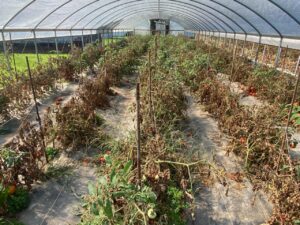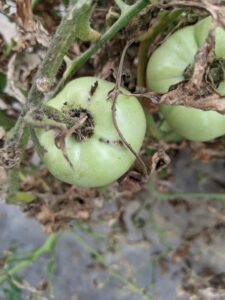Introduction to the insect

Tomato pinworm “TPW” (Keiferia lycopersicella) is a small microlepidopteran pest of solanaceous crops with a strong preference for tomato. It naturally occurs in warm climates of the U.S., including Texas, Florida, Hawaii, and California. It cannot survive outdoors in temperate climates, such as Indiana, where winter temperatures exceed a low threshold of 50° F that prohibits survival. However, over the last few years, we’ve heard of 2 or 3 unusual cases of high tunnel tomato producers losing entire crops of their tomatoes, with plants suddenly looking brown and covered in leaf mines/tunnels. After collecting specimens, we’ve confirmed the very hungry and tiny culprit is TPW.
Identifying tomato pinworm damage

Early instars of TPW caterpillars are light-colored (yellow to green) and will feed in leaf mines. Unlike the leaf mining fly (Liriomyza brassicae), TPW mines are not narrow and meandering. TPW mines are blotchy and present in folded leaves. Older instars may remain within the leaves or exit to infest the fruit before they drop to the ground to pupate. Mines into the fruit are typically near the stem and will be indicated by a pinhole; small round entrances surrounded by dark frass or excrement from the caterpillar inside the fruit. The adult stage of this insect is a tiny (~1/4-inch long), drab-colored moth that can be easy to miss, and the caterpillars can be devastating to your crop if they are not detected and managed early.
Pheromone lures to monitor activity

Scouting for adults can occur by deploying pheromone-baited traps at planting and checking them weekly for small, drab moths. However, correct identification of pinworm adults can be difficult, and therefore, we recommend sending specimens to the Purdue Plant and Pest Diagnostic Laboratory. The trap that we employ is called a wing trap and consists of two rectangular pieces of plastic that serve as the outer supports of the trap. Within this shell we place a sticky board that will capture and collect the insects that enter the space between the outer supports. On the middle of this trap, we place a rubber septum infused with the pheromone (smell) of the female moths. Male moths are attracted to this smell and will enter the trap in search of a female. Therefore, when we begin to accumulate moths in the trap, it is an indication that the adult stage of the pest is present, and that females are mating and laying eggs on the suitable host plant, tomato! The presence of these adults signals the correct time to apply pesticides to the crop, if that is the method of control you choose. Refer to the Midwest Vegetable Production Guide for more information on insecticides for Tomato pinworm (pest category = caterpillars). It is imperative that the caterpillar receives a lethal dose as it hatches from the egg and before it mines into the leaf tissue and becomes protected from foliar application.
